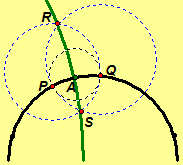2.7.2 Hyperbolic Parallel Postulate
![]() Printout
Printout
Out of nothing I have created a strange new
universe.
—![]() János Bolyai (1802–1860)
János Bolyai (1802–1860)
Hyperbolic Parallel Postulate.
Through a point not on a line
there is more than one line parallel to the given line.
As with the Euclidean Parallel Postulate,
there are many statements that are equivalent to the Hyperbolic Parallel
Postulate. A sample list is given below. Note the similarity to the equivalent
Euclidean postulates; from this pattern we should be able to see many other
equivalent statements. The Poincaré Half-plane is a model of a hyperbolic
geometry, with which we have completed several examples in previous sections.
The Poincaré Disk is another model of a hyperbolic geometry.
Click here for a
![]() illustration of the Poincaré Disk
or investigate the Poincaré Disk with interactive java software
illustration of the Poincaré Disk
or investigate the Poincaré Disk with interactive java software
![]() NonEuclid. This survey course will not develop or prove any of the concepts in hyperbolic
geometry. The exercises below are meant to explore basic principles, without
proof. Many books on non-Euclidean geometry thoroughly develop the concepts of
hyperbolic geometry, see those for proofs.
NonEuclid. This survey course will not develop or prove any of the concepts in hyperbolic
geometry. The exercises below are meant to explore basic principles, without
proof. Many books on non-Euclidean geometry thoroughly develop the concepts of
hyperbolic geometry, see those for proofs.
Hyperbolic Proposition 2.1. The sum of the measures of the
angles of a triangle is less than 180.
Hyperbolic
Proposition 2.2. Similar triangles are congruent triangles.
Hyperbolic
Proposition 2.3. Through a given point not on a line there are
infinitely many lines parallel to the given line.
Hyperbolic
Proposition 2.4. The
summit angles of a
Saccheri quadrilateral each
measure less than 90.
Hyperbolic
Proposition 2.5. No quadrilateral is a
rectangle.

Use dynamic geometry software with the Poincaré
Half-plane for the construction investigations (Geometer's Sketchpad, GeoGebra, or
![]() NonEuclid). The script for Geometer's Sketchpad
or GeoGebra Poincaré Half-plane is in
Appendix B of the
Title Page and Index. Make sure you use the Poincaré
Half-plane construction tools for lines, rays, segments, angles, circles, etc.
Do not use the Euclidean tools.
NonEuclid). The script for Geometer's Sketchpad
or GeoGebra Poincaré Half-plane is in
Appendix B of the
Title Page and Index. Make sure you use the Poincaré
Half-plane construction tools for lines, rays, segments, angles, circles, etc.
Do not use the Euclidean tools.
Exercise 2.68. Construct a triangle in the Poincaré
Half-plane. (a) Find the sum of the measures of the angles. (b) Find a triangle where the sum of the
measures of the angles is less than 5.
(c) Find a triangle where the sum of the measures is more than 175.

Exercise
2.69. (a) Construct two
perpendicular lines in the Poincaré Half-plane, as illustrated on the right.
(b) Prove the two lines are perpendicular.
(c) Is this construction valid for a neutral geometry (or Euclidean geometry)?
Explain.![]()
Exercise
2.70. Use the procedure from Exercise 2.69 for this exercise. (a) Construct a
Saccheri quadrilateral in the Poincaré Half-plane that has the base and sides all
congruent. (b) May we say that in a hyperbolic world, "No body is a 'square'."?
Explain.
Exercise
2.71. (a) Construct a quadrilateral
in the Poincaré Half-plane
that has three right angles. (This quadrilateral is called a Lambert quadrilateral after
![]() Johann Lambert (1728–1777).) (b) What is the measure of the fourth
angle? (c) Prove or disprove that a
Lambert quadrilateral is a parallelogram.
(d) Is the result of part (c) valid for a neutral geometry (or Euclidean
geometry)?
Johann Lambert (1728–1777).) (b) What is the measure of the fourth
angle? (c) Prove or disprove that a
Lambert quadrilateral is a parallelogram.
(d) Is the result of part (c) valid for a neutral geometry (or Euclidean
geometry)?
Exercise
2.72. (a) Construct two parallel lines
in the Poincaré Half-plane by constructing them perpendicular to the same line.
(b) What happens with the distance between the two parallel lines as you move
away from the perpendicular line?
Exercise
2.73. Investigate the question: In the Poincaré Half-plane, do two
parallel lines always have a common perpendicular? If they do not always have a common
perpendicular, how are the two parallel lines related?
Exercise
2.74. Use the models definitions, not Geometer's Sketchpad
or GeoGebra for this
exercise. Given A(0, 2), B(0, 1), C ,
and D
in the Poincaré Half-plane. (a) Show quadrilateral ABCD is a
Saccheri quadrilateral.
(b) How do the lengths of the summit and base compare?